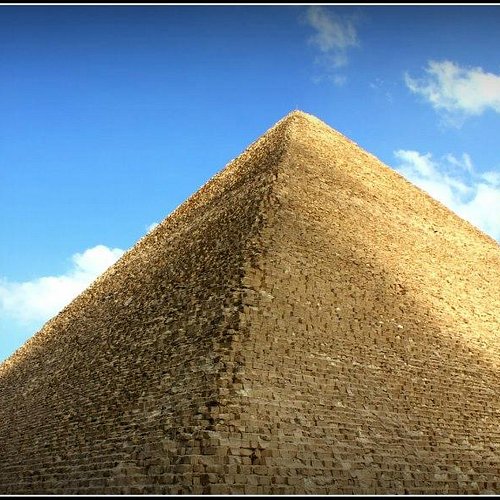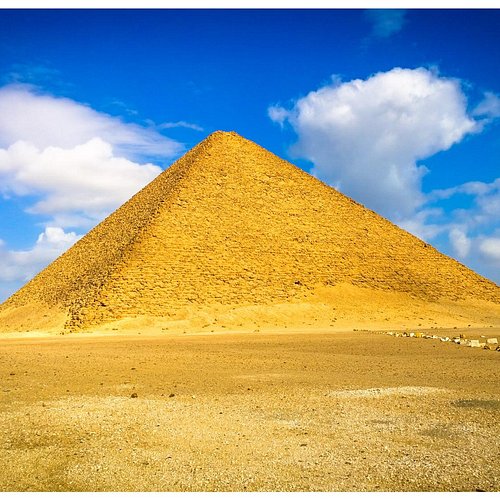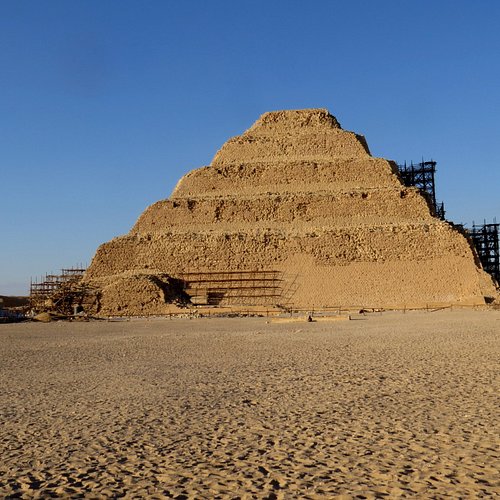10 Points of Interest & Landmarks in Giza Governorate That You Shouldn't Miss
Discover the best top things to do in Giza Governorate, Egypt including Tomb of Idut, Great Pyramid of Cheops (Khufu), Niankhkhnum and Khnumhotep's Mastaba, North Pyramid (Piramide Roja), Step Pyramid of Djoser, Mastaba of Mereruka, Tomb of Kangemni, Mena Papyrus, Pyramid of Teti, Pharaonic Village.
Restaurants in Giza Governorate
1. Tomb of Idut
Overall Ratings
5.0 based on 10 reviews
Reviewed By Brun066 - Florence, Italy
I had already been - about fifteen years ago - in Saqqara, but I hadn't visited the painted tombs of the royal princes; so this visit was new to me. Princess Shesheshet Idut is one of the five daughters of Unas, traditionally considered the last pharaoh of the V dynasty (and who reigned around the middle of the 24th century BC). With Unas the dynasty would probably end because he had no male children who survived him. The pyramid of Unas, very deteriorated, is a few tens of meters west from this tomb.. The tomb isn't normally open. When we visited it, it was opened by a caretaker, upon payment of an additional entrance ticket. The tomb is made up of a succession of parallelepiped-shaped rooms, all the way to the final room, which ends with the "false door", a communication route between the world of the living and that of the dead. The walls of the rooms bear a memorable series of quite realistic depictions, carved in bas-relief and painted, relating to the sacrifices celebrated for the deceased, to the transport of offerings to the tomb, to scenes set along the Nile or its shores. Historians and archaeologists explain that in the tombs of the Old Kingdom, unlike in later ones, the number of objects of use is limited. On the other hand, many offers to be consumed are transported to the grave: animals still alive, quarters of beef, other foods. Among the scenes that struck me most: those - repeatedly depicted - relating to the bloody sacrifices of the calves: the unhappy animals, tied and still alive, had their legs truncated at the root before (or simultaneously with) the slaughter. Then the naturalistic depictions of the Nile (or even of other water bodies?), featuring different fish species, drawn in detail, and the rich fauna that populates the shores. Finally the dramatic scene - always set in the Nile - of a hippopotamus female about to give birth, while a crocodile, lurking behind her, the mouth wide open, is preparing to swallow the hippo puppy as soon as it comes out completely from the uterus: representation, to what it has been explained to us, of the idea of how faint the boundary between life and death is. To think that these striking and almost intact scenes - of which the Saqqara archaeological site is rich, unlike the Gizah one - date back almost four and a half millennia ago, gives a sort of vertigo, and authorizes me to say that the visit to the tombs painted by Saqqara (among which this one excels) is one of the strongest experiences on a trip to Egypt.
2. Great Pyramid of Cheops (Khufu)
Overall Ratings
4.5 based on 7,157 reviews
The largest and oldest of the Giza pyramids, this colossal structure stands nearly 500 feet tall.
Reviewed By raghu67 - Bengaluru, India
The Great Pyramid of Giza also known as the Pyramid of Khufu or the Pyramid of Cheops once among the Seven Wonders of the Ancient World, is the oldest and largest of the three pyramids in the Giza pyramid complex. This pyramid was built as a tomb for the Fourth Dynasty Egyptian pharaoh Khufu and was constructed over a period of 20-year period from 2575 -2566 BC. Khufu followed the design of Red Pyramid which was built by his father Sneferu. This Pyramid erected on a rocky plateau had all the elements like the burial chambers, mortuary temple and covered causeways connected to the banks of river Nile. Estimated to be built using around 2,300,000 lime stones weighing around 5.5 million tons , 8,000 tons of Aswan granite and 500,000 tons of mortar, its original height was around 480 feet. But due to erosion of the outer fine lime stone layer and damages caused due to earth quake, the height of this pyramid now stands at around 455 feet.
3. Niankhkhnum and Khnumhotep's Mastaba
Overall Ratings
4.5 based on 17 reviews
Reviewed By TravelGipsy - Naples, United States
Thanks to our wonderful guide Hend. We’ve been several times, but never we saw the wonderful places that most tours miss. That is the difference between a great guide!
4. North Pyramid (Piramide Roja)
Overall Ratings
4.5 based on 76 reviews
Reviewed By kaziy - Dhaka City, Bangladesh
The Red Pyramid or the North Pyramid was the third pyramid built by Old Kingdom Pharaoh Sneferu, the father of Khufu, who built the Great Pyramid at Giza. It is the largest of the three major pyramids located at the Dahshur necropolis in Cairo, Egypt. Named for the rusty reddish hue of its red limestone stones, it is also the third largest Egyptian pyramid, after those of Khufu and Khafra at Giza. The Red Pyramid was to be first successful attempt to construct a true pyramid, Much less crowded than Giza and one more thing is that you can enter inside the pyramid. There are three Chambers inside the Pyramid. First two chambers are at ground level, while a third chamber is higher, built within the masonry of the pyramid itself.
5. Step Pyramid of Djoser
Overall Ratings
4.5 based on 585 reviews
Reviewed By ukienomad - Fleming Island, United States
Step Pyramid of King Zoser was built in the 27th century BC. and the beginning of Dynasty 3, possibly the first pyramid Constructed in Egypt. It’s more than 200 feet tall, and the oldest stone structure of its size in the world. The inside of the tombs have murals that provide insights into every day life in ancient Egypt. Be sure to peer into the serdab, a stone structure in front of the pyramid with two eye-holes that invites you to look deeper inside. When you do, you will discover a remarkably life-like painted limestone statue of Zoser looking back at you. An amazing experience to walk through ancient history.
6. Mastaba of Mereruka
Overall Ratings
4.5 based on 44 reviews
Dating back to the 6th Dynasty (2323-2150 BC), this is the largeset tomb complex in Saqqara housing the remains of Mereruka (vizier to King Teti I), magnificent wall paintings, a stone ring for tethering sacrificial animals and a life-size statue of Mereruka walking forward from a false door.
Reviewed By DEK_29 - Brisbane, Australia
This mastaba is situated just outside and slightly down from the Step Pyramid of Djoser. Having 33 rooms, the painting on the walls feature everyday scenes that include, farming, harvesting, fishing and other common folk pursuits. Mereruka was an official in the Old Kingdom during the time of 6th Dynasty pharaoh Teti 1. He had numerous titles including vizier, hence why he mastaba is close to the Pyramid of Teti 1. Some of the original paint work has remained which provides a glimpse into the past of pharaonic Egypt.
7. Tomb of Kangemni
8. Mena Papyrus
9. Pyramid of Teti
Overall Ratings
4.5 based on 10 reviews
Reviewed By DEK_29 - Brisbane, Australia
The pyramid of Teti I was built during the Sixth Dynasty of the Old Kingdom. It was a smooth sided pyramid and the second pyramid to have "Pyramid Texts". First opened by Gaston Maspero in 1882; it was known back in the old kingdom as Teti's Places Are Enduring. Nothing remains of the outer casings or stones of the pyramid as these were taken away and used elsewhere. These days, the pyramid is a pile of rubble however, a short crawl down a ramp (not as long as many others eg. Bent Pyramid at Dahshur) takes you into the burial chamber where you can see the walls covered in pyramid texts and ceiling covered in stars. Easy to traverse, although a number of connecting corridors are low - so you must crawl through them to other chambers. Free of charge, it is an experience that should be undertaken to give you a taste of entering pyramids.
10. Pharaonic Village
Overall Ratings
4.0 based on 256 reviews
Temporarily Closed the pharaohs cruising restaurants Imagine going to a place a few miles from the center of Cairo, Egypt. Where Egypt's entire history and art comes alive! Such a place exists in the Pharaonic Boat, on Jacob Island in the Nile.
Reviewed By mamakimsrescue - San Bruno, United States
History lovers dream! You can walk through a life size replica of Karnak Temple with its original paint job. The original temple is now the color of the desert sand and has many broken and missing objects. The replica has exterior and interior paint, colored hieroglyphics, sculptures, and rows of undamaged ram sphinxes. You can also walk through the home of both an ancient nobleman and a peasant, complete with costumed actors. The Nile River boat ride around the island is a must see!!! Employees dressed in costume literally re-enact scenes from ancient Egyptian life. For example, farming (with live oxen), boat building, honey making, fishing, brick making, pottery making, sculpting, perfume making, etc. I was mesmerized watching a recreation of the Biblical scene of Pharoah's daughter retrieving baby Moses from the actual Nile River. You can walk through a recreation of King Tut's tomb, with the items in their exact original location. I have been to King Tut's tomb in the Valley of the Kings and seen his tomb items at the Egyptian Museum. But walking down the infamous stairs to the tomb and seeing it just like Howard Carter did was exhilarating. There are 22 mini-museums: King Tut's Tomb, Cleopatra, Islamic, Coptic, Nasser, Napoleon, Nubian, etc I don't see any need to book an online guided tour. All of the museum exhibits have signs in English. And you can Google anything you want to know more about. Except for the fact that you will then have a safe ride back to your hotel.










